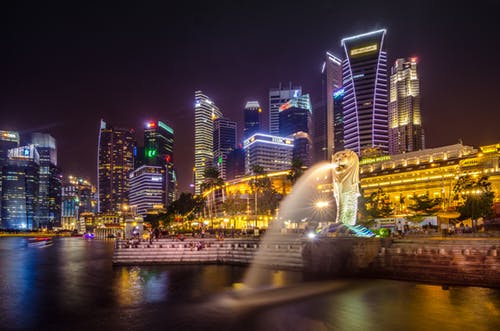Water is going to be a major concern for people around the globe. With the increasing needs of water by an exponentially growing population, the existing reservoirs are getting dried briskly, increasing high risk of water deficiency for the coming generations.
The water crisis is already causing tensions between the Asian countries with a natural resource of only 10 rivers, out of which 4 are going to dry out in a couple of years. India, Manila, Singapore, Pakistan are already into heated political disputes over the existing reservoirs which may affect a vast population already living in their river basins.
“We keep talking about how important (water) is but it is probably an area where the least cooperation is happening,” said Dechen Tsering, Asia-Pacific director at UN Environment.
Singapore has started acting smartly and is educating its public to use lesser water to conserve its water resources. Singapore currently uses 141 litres per person and by introducing gadgets like modified showers that use lesser amount of water per shower; it is trying to cut the water usage per person. This will allow Singapore to decrease its daily consumption by 8 percent by 2030.
Singapore is hit hard by the water crisis since the small island country gets almost half of its water by neighbouring Malaysia. According to the U.S.-based World Resources Institute, Singapore will be facing high water stress by 2040.
Currently, Singapore imports water from Malaysia’s Johor River, a deal done in 1927. This deal will be over in 2060 and is a matter of constant friction between the neighbours.
Malaysia is not happy on the price Singapore pays for its water. Its buys the water for 3 sens per 1000 gallons and sells it back after treatment for 50 sens per 1000 gallons.
The new Malaysian Prime Minister is not too happy with this price model and both countries are in talks to solve the issue through arbitration.
Singapore lacks its own water resources, and the climate changes and ongoing dispute with Malaysia has it thinking of other ways to manage the water crises independently.
Singapore is a wealthy nation and is investing highly in innovative technologies since 2006 to decrease water usage per person, recycle-reuse water and run public campaigns to conserve water in daily usage.
As a general practice, it urges the public to use buckets instead of a hose to wash a car, save water during dish washing and using a shower by not leaving taps open for long.
“We (Singapore) are nowhere near water independence and heavily reliant on Malaysia,” said a local resident: Reutens-Tan, whose family attended a water conservation boot camp last month.
“It is crucial to be water independent,” he told the Thomson Reuters Foundation. “No one should have to rely on someone else for a basic need.”
The family seems to be a role model in water conservation since their utility bills show they have used less than half of the Singaporean average.
The ‘Four taps’
As a wise nation, Singapore realizes its short of the natural water reservoirs, it has put all efforts to overcome the issue by working on the national master plan “national taps”: catching rainfall in reservoirs, recycling water, desalinating water, and imports.
Ever since the independence, Singapore has tuned up its water resources by cleaning its rivers and canals, keeping a strict eye on water leakages in drainage systems, recycle/distill/reuse the water, store the rain water in its 17 reservoirs built over the years and constantly educate the public about using its water with better strategy.
The nation currently uses about 1.95 billion litres per day, the usage is going to increase in coming years since the population is growing and more and more people from around the world are moving in the wealthy country.
The country has also invested in five wastewater recycling plants that now provide 40 percent of Singapore’s water needs – a figure the city-state hopes will rise to 55 percent by 2060.
“Ever more cities worldwide recycle wastewater but whether every drop can be reused depends on the attitude of users”, said Cecilia Tortajada, senior research fellow at the Institute of Water Policy at the National University of Singapore.
Industries are more likely to use recycled water, however, people are still hesitant to use it as drinking water.
As another measure, three desalination plants are setup to turn seawater into drinking water, with more plants to be added in future. These plants can attribute 30% of the country’s water demand, sources said.
Desalination process is quite hectic, making it a lesser favourite process, however, the newer, advanced technologies may ease the process.
Water independence?
“Today, the possibility that Singapore could become totally self-sufficient and give up imports is no longer unthinkable”, said King Wang Poon, director of the Kuan Yew Centre for Innovative Cities at Singapore University of Technology and Design.
“When we started, we didn’t think it would be possible to do 100 percent,” he said. “But given that solar (power) is more viable for better desalination, I think there’s a good chance by 2061 we would be 100 percent,” he said.
In Singapore, Poon added, “water policy has become the thing that all other policies had to bend to”.
“The biggest barrier may actually be the low cost of water from Malaysia”, said Gabriel Eckstein, president of the International Water Resources Association.
“My understanding is that Singapore could already achieve (independence) today,” he said. “It doesn’t make economic sense to become fully self-sufficient at the moment.”
Tortajada of the Institute for Water Policy, Singapore had some interesting comments on how the country has managed the water issue:
- Singapore’s increasingly successful push for water security is, however, unlikely to be repeated in other Asian cities any time soon
- Singapore’s focus on innovation and its flexibility, are key to its progress.
- There is a lot of (water) policy innovation in Singapore, which is something you don’t normally see.
- Despite its rigorous system of planning, Singapore was “not afraid to change the plan. If something doesn’t work, they adapt and modify it.”
Lack of cash, pollution, corruption and inefficiency all stand in the way, she and other water experts said.
Aiming lower
As a responsible citizen, Reutens-Tan supports Singapore’s water conservation initiatives as good first steps but also things more strict actions need to be taken by PUB, the national water agency if it wants to meet the conservation targets.
In order to get the target of 130 litres per person, the country needs to impose stricter rules and set higher prices on its residents.
While the general thought is that Malaysia will never turn its back on using its river water, there could be other reasons, for example, a climate change, drought, that could force the country to rethink over the water treaty.
“In that case, Malaysia can simply say that they need it for themselves and they wouldn’t be wrong in putting their people first”, said Reutens-Tan.
The article originally appeared on The Jakarta Post







